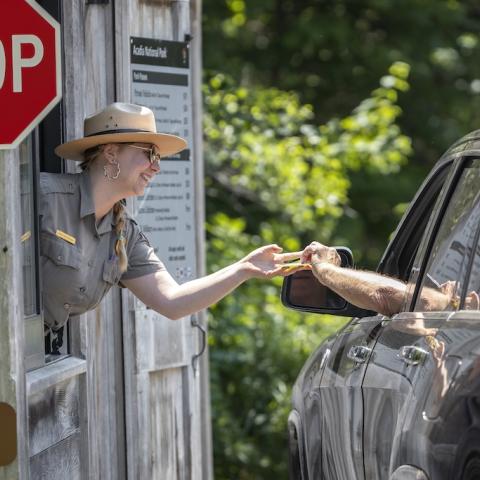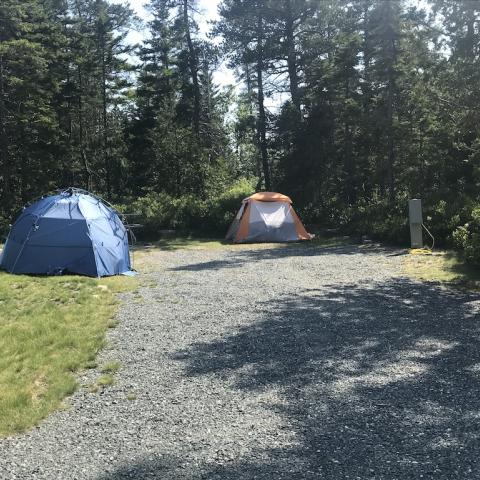
Isle au Haut, the quiet side of Acadia National Park/Kim O'Connell
Acadia’s Isle au Haut offers travelers a welcome escape from the crowds on Mount Desert Island
It was a bluebird-sky day in late September, and I was all alone in the woods. I’d been hiking for about an hour, hearing nothing but my soft footfalls on the dirt path, the sloshing of my water bottle, and my own breathing. Faintly at first, then more insistently, I began to notice a crashing and roaring sound. Finally, I emerged from the tranquil forest to see waves pounding the cobblestone beach at Western Head, a dramatic change from the quiet of the trail just moments before. Beyond the shoreline, an unbroken expanse of deep blue water stretched to the horizon. I sat down on a boulder to take it all in. This was Isle au Haut, a rocky island off the central coast of Maine that feels like the edge of the world.
Pronounced “i-la-ho,” Isle au Haut is located about 15 miles (as the crow flies) southwest of Mount Desert Island (MDI), home to most of Acadia National Park. Since 1944, about half of Isle au Haut has been preserved and managed as part of Acadia as well, although, like the Schoodic Peninsula section of the park, it is far less visited. Fewer than 10,000 visitors venture to the island each year, compared to MDI’s more than 3 million annual visitors. I had come there for five days as an artist-in-residence for Acadia, staying in an early 20th-century cabin usually reserved for park rangers. From there, I was free to explore the island’s verdant forests and rocky cliffs, far from the crowds on Mount Desert Island.
Isle au Haut—“High Island” in French—was so named by French explorer Samuel de Champlain when he was exploring Penobscot Bay in the early 1600s (a prominent peak on MDI is named for him). According to historians, Native Americans and small numbers of working families used the island in the intervening centuries, mostly dependent on fishing and lobstering. It was not until the late 19th century that the island became known to outsiders, mostly artists and pleasure-seekers. In 1879, a landscape architect named Ernest Bowditch, a contemporary and friend of Central Park designer Frederick Law Olmsted, found the island quite by chance after taking a boat ride to get away from his crowded hotel in Bar Harbor—the largest town on MDI both then and now. Bowditch and his partners soon bought land on the island to create a summer colony that centered on the exclusive Point Lookout Club, which was instantly popular with upper-class investors and vacationers from Boston, New York, Philadelphia, and elsewhere. As Outing magazine enthused in 1885, according to a history compiled by Douglas Deur, “Golden indeed are the days one passes at the Club House, for never were quiet and tranquility more absolute than here.”
Bowditch died in 1918. During World War II, his descendants approached the National Park Service with the idea of donating their extensive land holdings to be incorporated into Acadia, a transaction that was made official in 1944. According to oral histories, the presence of the park was not universally welcomed by locals at first, as early park visitors would sometimes picnic and camp on private property. As a concession, the Park Service built a park-only dock on the island’s southern tip, and locals have since largely come to accept and appreciate the park’s presence.

This is the way to Duck Harbor/Kim O'Connell
Today, the parklands on Isle au Haut are crisscrossed with trails, where solitude abounds. From mid-May through mid-October, the scenic Duck Harbor Campground, located on the island’s southern end, is open to campers as well, featuring five three-sided log shelters for tents, as well as picnic tables, fire rings, composting toilets, and access to fresh water. (Reservations are required.)
My own arrival on the island felt like I’d stepped through a portal. From the mainland, my approach to the port at Stonington, my departure point, had been curtained with thick fog. At Stonington, I was directed to park my car and board the mailboat managed by Isle au Haut Boat Services, the only public way to get to or from Isle au Haut. Knowing I’d have no car during my stay on the island, I quickly offloaded some oranges, a book, and an extra pair of shoes in a last-minute quest to lighten my load. From there, I shouldered my pack and boarded the boat, from which I could just make out a few lobster boats in the fog. A handful of other passengers eventually joined me on board, a mix of local residents and tourists who were staying at the Keeper’s House Inn, the island’s only bed-and-breakfast, located at the charming, white-painted Isle au Haut Lighthouse near the town. Most passengers disembarked at the town landing, leaving me to ride on to the Park Service dock. From there, a park ranger met me and drove me to the trailhead that led to my cabin. Then I was on my own.

Small treasures in the forests of Isle au Haut/Kim O'Connell
Over the next few days, I experienced the kind of true solitude that is so rare not only in our modern times, but in many national parks. It was prime fall leaf-peeping season, and upon my arrival in Acadia I had tried to find parking on the summit of Cadillac Mountain or near Jordan Pond—two of the most popular areas on MDI—without success, due to the crowds. Isle au Haut was completely different. To the sounds of morning birdcalls, I brewed coffee on a Coleman stove and boiled water to rehydrate my camp food. At night, I burrowed down into a warm sleeping bag, falling asleep to the sound of Eli’s Creek burbling nearby.
During the day, I explored many of the park trails, crossing paths with other hikers only two times in nearly five days. The Duck Harbor Trail was a largely tree-lined path that sometimes dipped along shell-covered beaches and across creeks and marshy areas. The Cliff Trail took me high along the bluffs of Western Head, where water rushed into a series of shadowy coves. One day, I hiked on the park road towards town, where I made a lunch of locally sourced goat cheese, crackers, and Maine-produced blueberry soda from the Island Store, a well-stocked grocery and gift shop that conveniently offers a couple picnic tables overlooking the water. (After several days of eating rehydrated food, the cheese and crackers felt decadent.)
My last day on Isle au Haut dawned bright and clear. I swept the pine needles off the porch of my cabin and packed out to the trailhead, where a park ranger picked me up to go back to the dock. Unlike the fog that had shrouded my arrival, the sun blazed off the blue water as the mailboat pulled away from the dock. Squinting in the sun, I watched Isle au Haut recede in the distance for as long as I could. Then, before I knew it, I was back on the mainland, another face in the crowd.

Evening quiet and beauty on Isle au Haut/Kim O'Connell




 Support Essential Coverage of Essential Places
Support Essential Coverage of Essential Places






